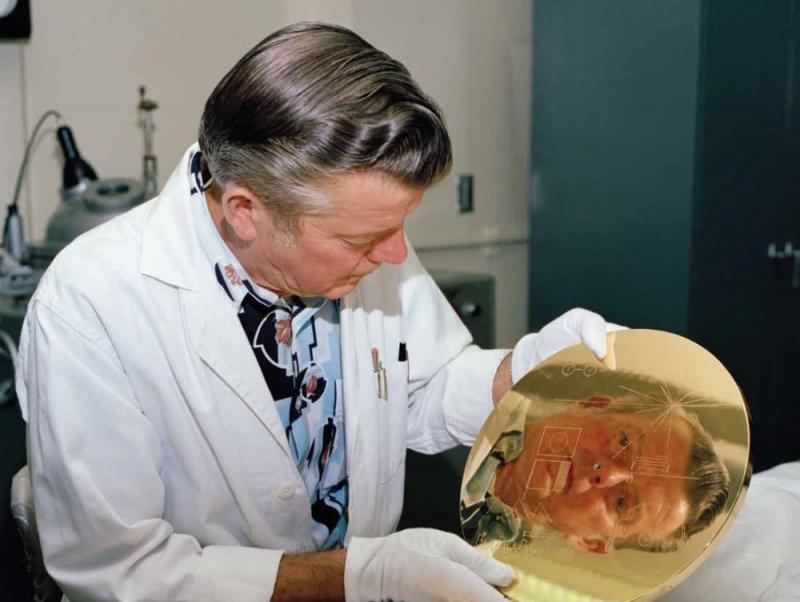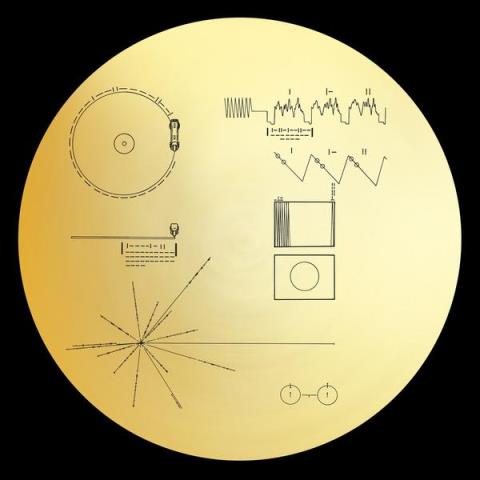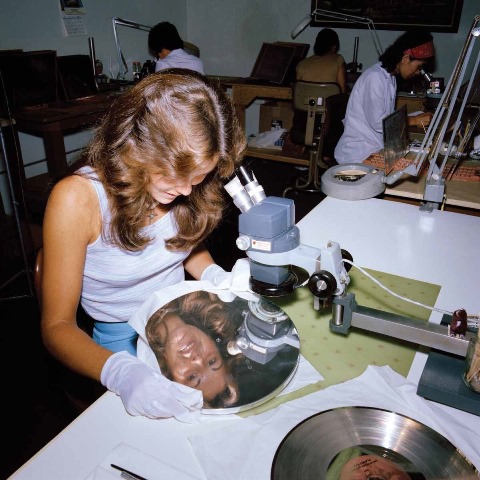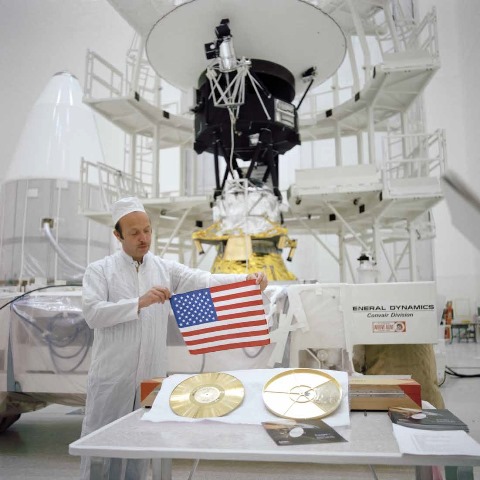Reissue CDs Weekly: The Voyager Golden Record | reviews, news & interviews
Reissue CDs Weekly: The Voyager Golden Record
Reissue CDs Weekly: The Voyager Golden Record
A chance to hear what was intended for extra-terrestrials in the Voyager space probes

What is music? When pondering archive releases, compilations and reissues the question doesn’t come up. Knowledge of context and history means there’s never a need to muse on this fundamental issue. A package, say, dedicated to Northern Soul says what it is and the prime considerations are how well it has been executed and defining its place in the relevant narrative.
However, the release of the Voyager Golden Record raises this concern. Twenty-seven pieces of music are collected, ranging from a Navajo Chant to part of Beethoven’s Fifth Symphony, from a recording of Peruvian panpipes and drum to Chuck Berry’s “Johnny B. Goode”. The tracks were not compiled for human or even animal ears. They were selected as, in the words of the package’s producers, they told part of “a story of our planet expressed in sounds, images, and science: Earth’s greatest music from myriad peoples and eras, from Bach and Beethoven to Blind Willie Johnson and Chuck Berry, Benin percussion to Solomon Island panpipes.” The potential recipients of this story? Any aliens encountering the Voyager 1 and Voyager 2 space probes after their departure from this solar system.
 Voyager Golden Record is a reissue of what was, again in the producers’ words, “mounted to each of these [two] spacecraft…a stunning golden phonograph record, an interstellar message to introduce our civilization to extra-terrestrials who might encounter the probes, perhaps billions of years from now.” The music was accompanied by spoken word sections – including greetings in 55 languages – an aural collage titled “The Sounds of Earth” and a recording of whales. All of this is collected on Voyager Golden Record.
Voyager Golden Record is a reissue of what was, again in the producers’ words, “mounted to each of these [two] spacecraft…a stunning golden phonograph record, an interstellar message to introduce our civilization to extra-terrestrials who might encounter the probes, perhaps billions of years from now.” The music was accompanied by spoken word sections – including greetings in 55 languages – an aural collage titled “The Sounds of Earth” and a recording of whales. All of this is collected on Voyager Golden Record.
The questions raised by this singular venture resolve themselves down to whether these putative extra-terrestrials would understand or even recognise the instructions within the space probes as to what this object fixed to its wall was and, if they did play the record, whether they had the ability to identify sound and then figure out what these sounds were. Is music a universal language? We are unlikely to find out: if the records in the vessels are heard, the likelihood of finding out any reaction must be close to nil.
 In the new package’s book Timothy Ferris, who produced the original record, says “we simply don’t know enough about extra-terrestrial life to state with any confidence whether the golden records will ever find an audience.” His subsequent explanation in the text of how aliens may work out what the records are is immensely compelling.
In the new package’s book Timothy Ferris, who produced the original record, says “we simply don’t know enough about extra-terrestrial life to state with any confidence whether the golden records will ever find an audience.” His subsequent explanation in the text of how aliens may work out what the records are is immensely compelling.
As Ferris acknowledges, we work with what we have and take chances. And this is what Carl Sagan did in early 1977 when he began the process which led to the creation of the two records. It wasn’t just music that was sent into space. Those behind the project also included pictures, giving a version of the full story of Earth.
Obviously, it’s impossible to approach this package as an alien. There are two versions. Each is beautifully presented. A box with a gold image of the original discs contains three transparent gold-vinyl records and a fully illustrated softback book covering the story of the project and the related issues. The book also includes reproductions of all the photographs sent into space, each scanned from the master slides. Additionally, there are wonderful photographs taken by the cameras on the Voyager probes and images from when the discs were in production. A double-CD set is presented as an LP-sized hardback book with the same contents.
 As an aural experience for us humans, this is a great listen. Every track has been officially licenced in and remastered in pin-sharp and dynamic fidelity. The inclusion of three Bach and two Beethoven compositions feels like overkill and, in the book, Ferris ties himself in knots addressing a possible surfeit of Western composers.
As an aural experience for us humans, this is a great listen. Every track has been officially licenced in and remastered in pin-sharp and dynamic fidelity. The inclusion of three Bach and two Beethoven compositions feels like overkill and, in the book, Ferris ties himself in knots addressing a possible surfeit of Western composers.
But it is amazing that in 1977, before every type of music on the planet was easily available, before the codification and resultant commodification of World Music in the Eighties, music from Australia, Azerbaijan, Bulgaria, Benin, China, the Congo, India, Japan, New Guinea, Peru and the Solomon Islands was included. Overtures to include The Beatles were foolishly rejected by those handling the rights to use their music.
Above all, the Voyager Golden Record was and is a political project as it came from an America which sought to represent the best of humankind: to act as a – as the book puts it – “reminder of what we can achieve when we are at our best – and that our future really is up to all of us.” Peddlers of the divisive and negative would do well to purchase a copy and think hard about what they are pushing. Of course, though, for those committed to such dogma this is about as likely as an alien craft landing on the lawn of The White House.
- Next week: Big Time Operator – box set collecting the complete works of Zoot Money’s Big Roll Band
- Read more reissue reviews on theartsdesk
Explore topics
Share this article
The future of Arts Journalism
You can stop theartsdesk.com closing!
We urgently need financing to survive. Our fundraising drive has thus far raised £33,000 but we need to reach £100,000 or we will be forced to close. Please contribute here: https://gofund.me/c3f6033d
And if you can forward this information to anyone who might assist, we’d be grateful.

Subscribe to theartsdesk.com
Thank you for continuing to read our work on theartsdesk.com. For unlimited access to every article in its entirety, including our archive of more than 15,000 pieces, we're asking for £5 per month or £40 per year. We feel it's a very good deal, and hope you do too.
To take a subscription now simply click here.
And if you're looking for that extra gift for a friend or family member, why not treat them to a theartsdesk.com gift subscription?
more New music
 Album: The Waterboys - Life, Death and Dennis Hopper
An alternately involving then naff tribute to a countercultural film figurehead
Album: The Waterboys - Life, Death and Dennis Hopper
An alternately involving then naff tribute to a countercultural film figurehead
 Album: Miki Berenyi Trio - Tripla
Debut set from Lush singer-songwriter’s new trio
Album: Miki Berenyi Trio - Tripla
Debut set from Lush singer-songwriter’s new trio
 Album: Pigs Pigs Pigs Pigs Pigs Pigs Pigs - Death Hilarious
Geordie rockers’ pulverising psych metal is guaranteed to rattle windows
Album: Pigs Pigs Pigs Pigs Pigs Pigs Pigs - Death Hilarious
Geordie rockers’ pulverising psych metal is guaranteed to rattle windows
 Album: Elton John and Brandi Carlile - Who Believes in Angels?
Elton John & Brandi Carlile step out in style
Album: Elton John and Brandi Carlile - Who Believes in Angels?
Elton John & Brandi Carlile step out in style
 Album: Erlend Apneseth - Song Over Støv
Norwegian musical impressionist’s journey into the centre of a vortex
Album: Erlend Apneseth - Song Over Støv
Norwegian musical impressionist’s journey into the centre of a vortex
 Music Reissues Weekly: Yeah Man, It's Bloody Heavy
The ne plus ultra of British heavy rock
Music Reissues Weekly: Yeah Man, It's Bloody Heavy
The ne plus ultra of British heavy rock
 Album: Bryan Ferry and Amelia Barratt - Loose Talk
A match made in urban nightlife and the mysteries of everyday living
Album: Bryan Ferry and Amelia Barratt - Loose Talk
A match made in urban nightlife and the mysteries of everyday living
 Album: Will Smith - Based on a True Story
Big Willie’s back - but maybe he should’ve stayed home
Album: Will Smith - Based on a True Story
Big Willie’s back - but maybe he should’ve stayed home
 Album: Perfume Genius - Glory
Album seven from an artist carving out his own space in the most modernist of ways
Album: Perfume Genius - Glory
Album seven from an artist carving out his own space in the most modernist of ways
 Album: Alison Krauss & Union Station - Arcadia
Their first album in 14 years looks hard at the past, and its role in the present
Album: Alison Krauss & Union Station - Arcadia
Their first album in 14 years looks hard at the past, and its role in the present
 Lauren Mayberry, Barrowland, Glasgow review - solo star stays too close to the day job
The Chvrches singer mixed some great tunes with an overly heavy sound.
Lauren Mayberry, Barrowland, Glasgow review - solo star stays too close to the day job
The Chvrches singer mixed some great tunes with an overly heavy sound.
 Album: Toria Wooff - Toria Wooff
Assured but too measured debut album from Americana-inclined singer-songwriter
Album: Toria Wooff - Toria Wooff
Assured but too measured debut album from Americana-inclined singer-songwriter

Add comment